Analysis and Design of Discrete Root Locus and PID Controller Systems
VerifiedAdded on 2022/12/26
|19
|2810
|55
Project
AI Summary
This project delves into the analysis and design of a control system, focusing on discrete root locus and PID controller implementation. The project begins by discretizing a continuous-time transfer function using the zero-order hold (ZOH) method and then analyzes the system's behavior using root locus plots in both continuous and discrete domains. The impact of different sampling frequencies on system stability and gain bandwidth is investigated. The project then proceeds to design a discrete PID compensator, implemented using Matlab Simulink, to improve the system's performance. The analysis includes the effects of the PID controller on the root locus, and the step responses of both the uncompensated and compensated systems are compared to assess the improvements in steady-state error and transient response. The findings highlight the importance of stability analysis in both continuous and discrete time domains, the effects of sampling frequency, and the benefits of PID compensation in enhancing system performance. The project concludes with references to relevant sources.

Discrete Root locus and PID controller 1
Student
Professor
Control System
Date
Student
Professor
Control System
Date
Paraphrase This Document
Need a fresh take? Get an instant paraphrase of this document with our AI Paraphraser
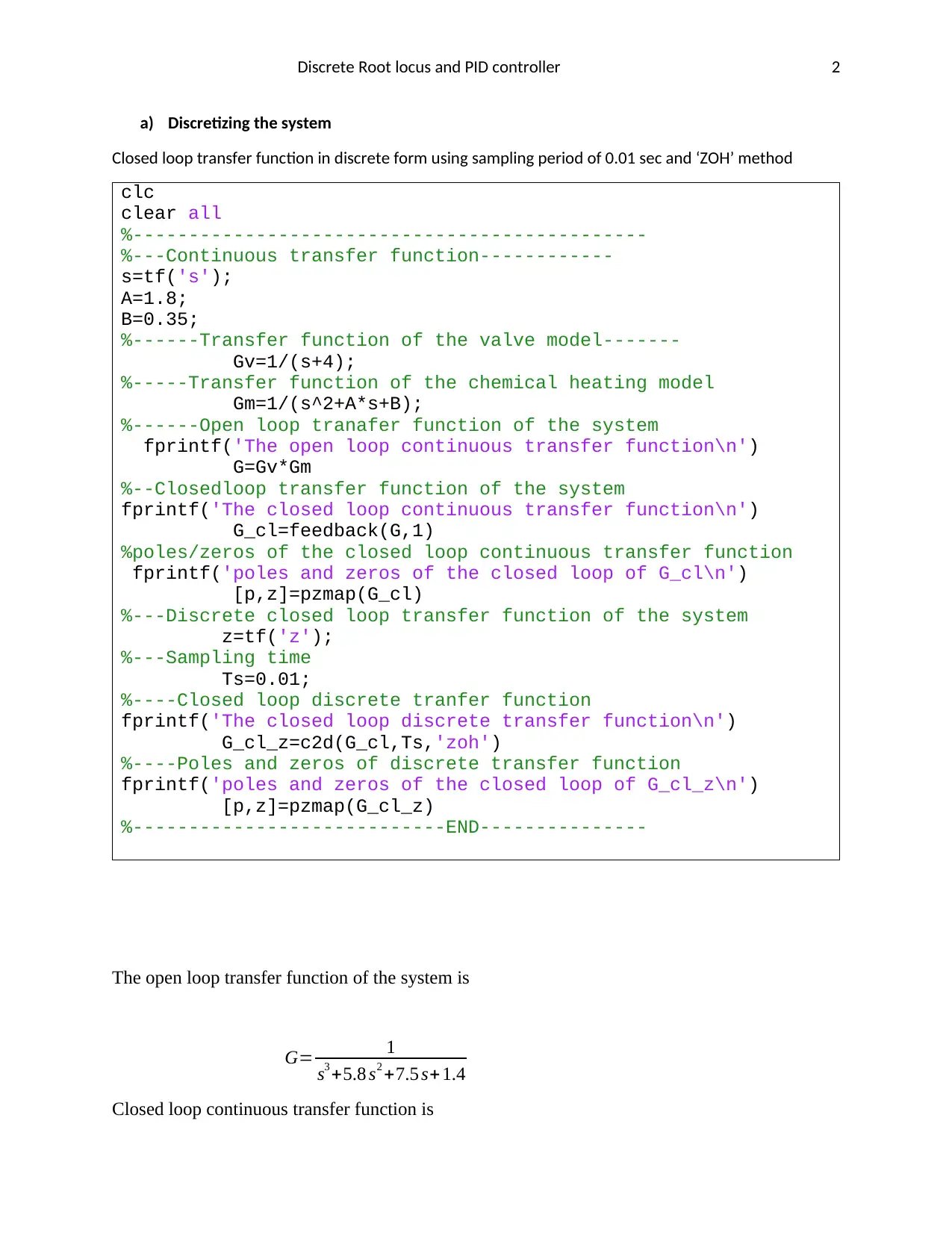
Discrete Root locus and PID controller 2
a) Discretizing the system
Closed loop transfer function in discrete form using sampling period of 0.01 sec and ‘ZOH’ method
clc
clear all
%----------------------------------------------
%---Continuous transfer function------------
s=tf('s');
A=1.8;
B=0.35;
%------Transfer function of the valve model-------
Gv=1/(s+4);
%-----Transfer function of the chemical heating model
Gm=1/(s^2+A*s+B);
%------Open loop tranafer function of the system
fprintf('The open loop continuous transfer function\n')
G=Gv*Gm
%--Closedloop transfer function of the system
fprintf('The closed loop continuous transfer function\n')
G_cl=feedback(G,1)
%poles/zeros of the closed loop continuous transfer function
fprintf('poles and zeros of the closed loop of G_cl\n')
[p,z]=pzmap(G_cl)
%---Discrete closed loop transfer function of the system
z=tf('z');
%---Sampling time
Ts=0.01;
%----Closed loop discrete tranfer function
fprintf('The closed loop discrete transfer function\n')
G_cl_z=c2d(G_cl,Ts,'zoh')
%----Poles and zeros of discrete transfer function
fprintf('poles and zeros of the closed loop of G_cl_z\n')
[p,z]=pzmap(G_cl_z)
%----------------------------END---------------
The open loop transfer function of the system is
G= 1
s3 +5.8 s2 +7.5 s+ 1.4
Closed loop continuous transfer function is
a) Discretizing the system
Closed loop transfer function in discrete form using sampling period of 0.01 sec and ‘ZOH’ method
clc
clear all
%----------------------------------------------
%---Continuous transfer function------------
s=tf('s');
A=1.8;
B=0.35;
%------Transfer function of the valve model-------
Gv=1/(s+4);
%-----Transfer function of the chemical heating model
Gm=1/(s^2+A*s+B);
%------Open loop tranafer function of the system
fprintf('The open loop continuous transfer function\n')
G=Gv*Gm
%--Closedloop transfer function of the system
fprintf('The closed loop continuous transfer function\n')
G_cl=feedback(G,1)
%poles/zeros of the closed loop continuous transfer function
fprintf('poles and zeros of the closed loop of G_cl\n')
[p,z]=pzmap(G_cl)
%---Discrete closed loop transfer function of the system
z=tf('z');
%---Sampling time
Ts=0.01;
%----Closed loop discrete tranfer function
fprintf('The closed loop discrete transfer function\n')
G_cl_z=c2d(G_cl,Ts,'zoh')
%----Poles and zeros of discrete transfer function
fprintf('poles and zeros of the closed loop of G_cl_z\n')
[p,z]=pzmap(G_cl_z)
%----------------------------END---------------
The open loop transfer function of the system is
G= 1
s3 +5.8 s2 +7.5 s+ 1.4
Closed loop continuous transfer function is
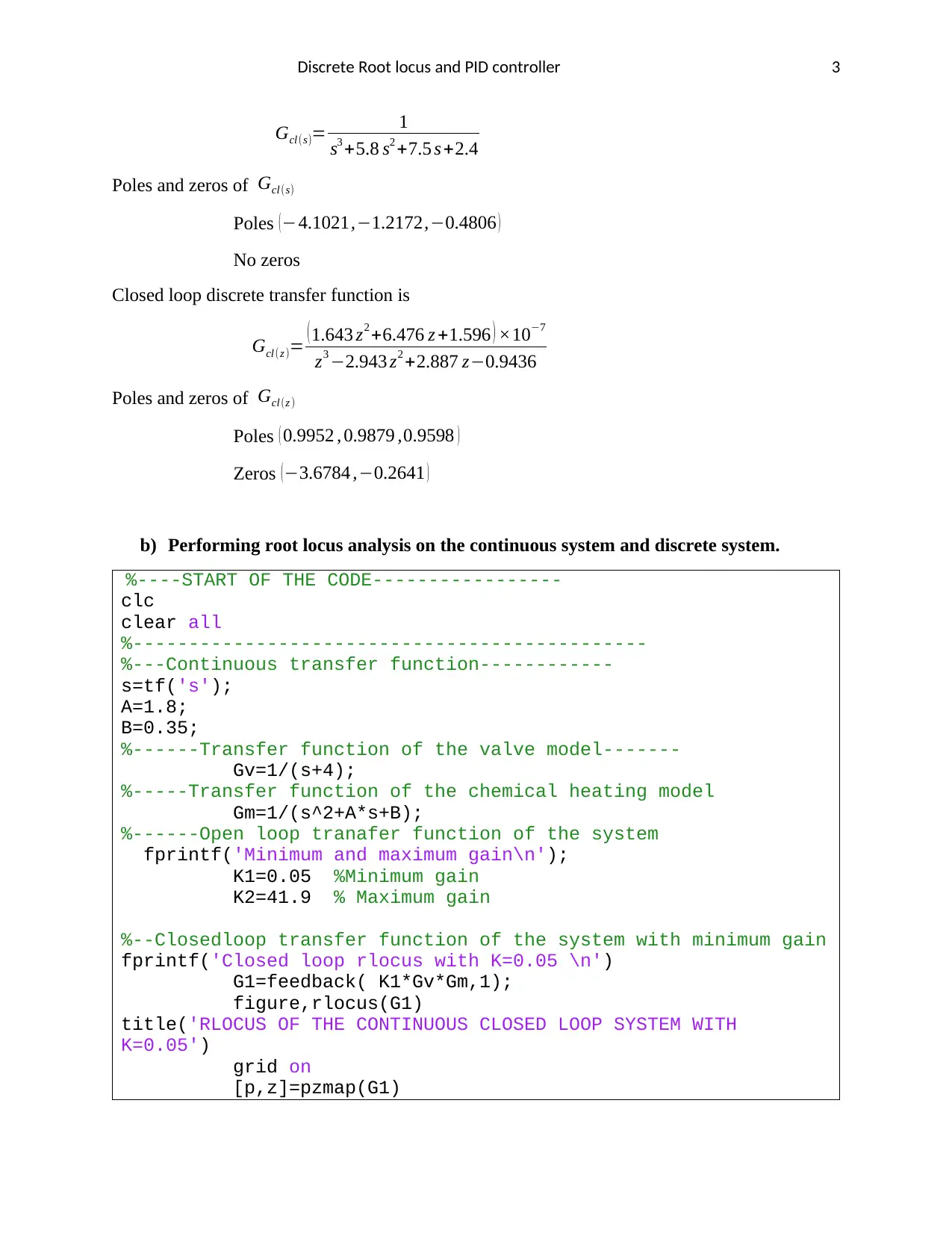
Discrete Root locus and PID controller 3
Gcl (s)= 1
s3 +5.8 s2 +7.5 s +2.4
Poles and zeros of Gcl (s)
Poles (−4.1021,−1.2172,−0.4806 )
No zeros
Closed loop discrete transfer function is
Gcl (z )= (1.643 z2 +6.476 z +1.596 ) ×10−7
z3 −2.943 z2 +2.887 z−0.9436
Poles and zeros of Gcl (z )
Poles ( 0.9952 , 0.9879 ,0.9598 )
Zeros ( −3.6784 ,−0.2641 )
b) Performing root locus analysis on the continuous system and discrete system.
%----START OF THE CODE-----------------
clc
clear all
%----------------------------------------------
%---Continuous transfer function------------
s=tf('s');
A=1.8;
B=0.35;
%------Transfer function of the valve model-------
Gv=1/(s+4);
%-----Transfer function of the chemical heating model
Gm=1/(s^2+A*s+B);
%------Open loop tranafer function of the system
fprintf('Minimum and maximum gain\n');
K1=0.05 %Minimum gain
K2=41.9 % Maximum gain
%--Closedloop transfer function of the system with minimum gain
fprintf('Closed loop rlocus with K=0.05 \n')
G1=feedback( K1*Gv*Gm,1);
figure,rlocus(G1)
title('RLOCUS OF THE CONTINUOUS CLOSED LOOP SYSTEM WITH
K=0.05')
grid on
[p,z]=pzmap(G1)
Gcl (s)= 1
s3 +5.8 s2 +7.5 s +2.4
Poles and zeros of Gcl (s)
Poles (−4.1021,−1.2172,−0.4806 )
No zeros
Closed loop discrete transfer function is
Gcl (z )= (1.643 z2 +6.476 z +1.596 ) ×10−7
z3 −2.943 z2 +2.887 z−0.9436
Poles and zeros of Gcl (z )
Poles ( 0.9952 , 0.9879 ,0.9598 )
Zeros ( −3.6784 ,−0.2641 )
b) Performing root locus analysis on the continuous system and discrete system.
%----START OF THE CODE-----------------
clc
clear all
%----------------------------------------------
%---Continuous transfer function------------
s=tf('s');
A=1.8;
B=0.35;
%------Transfer function of the valve model-------
Gv=1/(s+4);
%-----Transfer function of the chemical heating model
Gm=1/(s^2+A*s+B);
%------Open loop tranafer function of the system
fprintf('Minimum and maximum gain\n');
K1=0.05 %Minimum gain
K2=41.9 % Maximum gain
%--Closedloop transfer function of the system with minimum gain
fprintf('Closed loop rlocus with K=0.05 \n')
G1=feedback( K1*Gv*Gm,1);
figure,rlocus(G1)
title('RLOCUS OF THE CONTINUOUS CLOSED LOOP SYSTEM WITH
K=0.05')
grid on
[p,z]=pzmap(G1)
⊘ This is a preview!⊘
Do you want full access?
Subscribe today to unlock all pages.

Trusted by 1+ million students worldwide

Discrete Root locus and PID controller 4
fprintf('Step response with K=0.05 \n')
step(G1)
title('STEP RESPONSE WITH K=0.05')
stepinfo(G1)
%--------------------------------------------------------
%--cLOSED LOOP SYSTEM WITH k=41.9
%---------------------------------------------------------
fprintf('Closed loop rlocus with K=41.9 \n')
G2=feedback( K2*Gv*Gm,1);
figure,rlocus(G2)
title('RLOCUS OF THE CONTINUOUS CLOSED LOOP SYSTEM WITH
K=41.6')
grid on
[p,z]=pzmap(G2)
fprintf('Step response with K=41.9 \n')
step(G2)
title('STEP RESPONSE WITH K=41.9')
stepinfo(G2)
%----------END OF THE CODE-----------------
Fig 1: Rlocus of the continuous closed loop system with K=41.9
The root locus of the continuous system has poles and zeros located at;
fprintf('Step response with K=0.05 \n')
step(G1)
title('STEP RESPONSE WITH K=0.05')
stepinfo(G1)
%--------------------------------------------------------
%--cLOSED LOOP SYSTEM WITH k=41.9
%---------------------------------------------------------
fprintf('Closed loop rlocus with K=41.9 \n')
G2=feedback( K2*Gv*Gm,1);
figure,rlocus(G2)
title('RLOCUS OF THE CONTINUOUS CLOSED LOOP SYSTEM WITH
K=41.6')
grid on
[p,z]=pzmap(G2)
fprintf('Step response with K=41.9 \n')
step(G2)
title('STEP RESPONSE WITH K=41.9')
stepinfo(G2)
%----------END OF THE CODE-----------------
Fig 1: Rlocus of the continuous closed loop system with K=41.9
The root locus of the continuous system has poles and zeros located at;
Paraphrase This Document
Need a fresh take? Get an instant paraphrase of this document with our AI Paraphraser
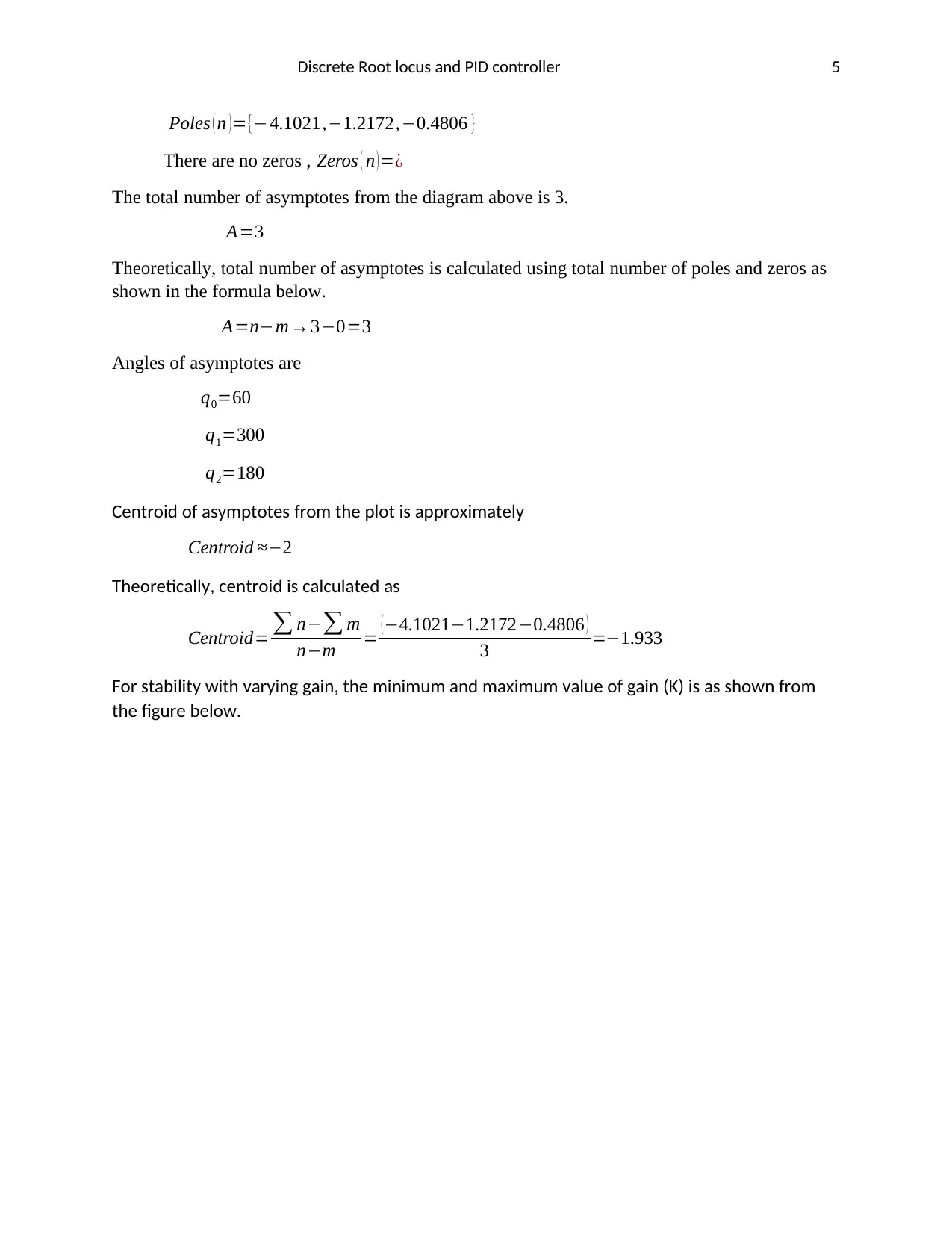
Discrete Root locus and PID controller 5
Poles ( n )={−4.1021,−1.2172,−0.4806 }
There are no zeros , Zeros ( n ) =¿
The total number of asymptotes from the diagram above is 3.
A=3
Theoretically, total number of asymptotes is calculated using total number of poles and zeros as
shown in the formula below.
A=n−m→3−0=3
Angles of asymptotes are
q0=60
q1=300
q2=180
Centroid of asymptotes from the plot is approximately
Centroid ≈−2
Theoretically, centroid is calculated as
Centroid= ∑ n−∑ m
n−m = ( −4.1021−1.2172−0.4806 )
3 =−1.933
For stability with varying gain, the minimum and maximum value of gain (K) is as shown from
the figure below.
Poles ( n )={−4.1021,−1.2172,−0.4806 }
There are no zeros , Zeros ( n ) =¿
The total number of asymptotes from the diagram above is 3.
A=3
Theoretically, total number of asymptotes is calculated using total number of poles and zeros as
shown in the formula below.
A=n−m→3−0=3
Angles of asymptotes are
q0=60
q1=300
q2=180
Centroid of asymptotes from the plot is approximately
Centroid ≈−2
Theoretically, centroid is calculated as
Centroid= ∑ n−∑ m
n−m = ( −4.1021−1.2172−0.4806 )
3 =−1.933
For stability with varying gain, the minimum and maximum value of gain (K) is as shown from
the figure below.
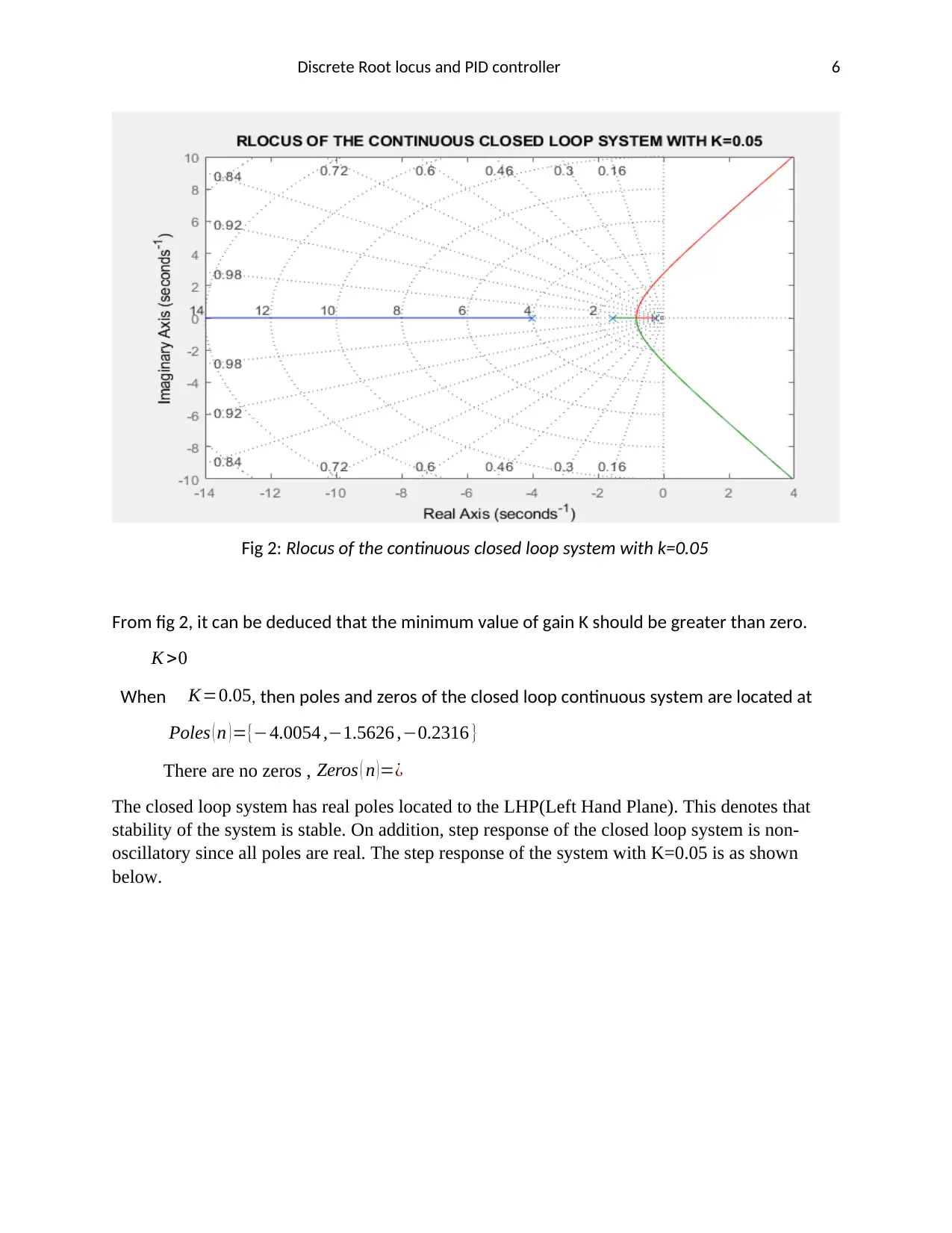
Discrete Root locus and PID controller 6
Fig 2: Rlocus of the continuous closed loop system with k=0.05
From fig 2, it can be deduced that the minimum value of gain K should be greater than zero.
K >0
When K=0.05, then poles and zeros of the closed loop continuous system are located at
Poles ( n ) ={−4.0054 ,−1.5626 ,−0.2316 }
There are no zeros , Zeros ( n ) =¿
The closed loop system has real poles located to the LHP(Left Hand Plane). This denotes that
stability of the system is stable. On addition, step response of the closed loop system is non-
oscillatory since all poles are real. The step response of the system with K=0.05 is as shown
below.
Fig 2: Rlocus of the continuous closed loop system with k=0.05
From fig 2, it can be deduced that the minimum value of gain K should be greater than zero.
K >0
When K=0.05, then poles and zeros of the closed loop continuous system are located at
Poles ( n ) ={−4.0054 ,−1.5626 ,−0.2316 }
There are no zeros , Zeros ( n ) =¿
The closed loop system has real poles located to the LHP(Left Hand Plane). This denotes that
stability of the system is stable. On addition, step response of the closed loop system is non-
oscillatory since all poles are real. The step response of the system with K=0.05 is as shown
below.
⊘ This is a preview!⊘
Do you want full access?
Subscribe today to unlock all pages.

Trusted by 1+ million students worldwide
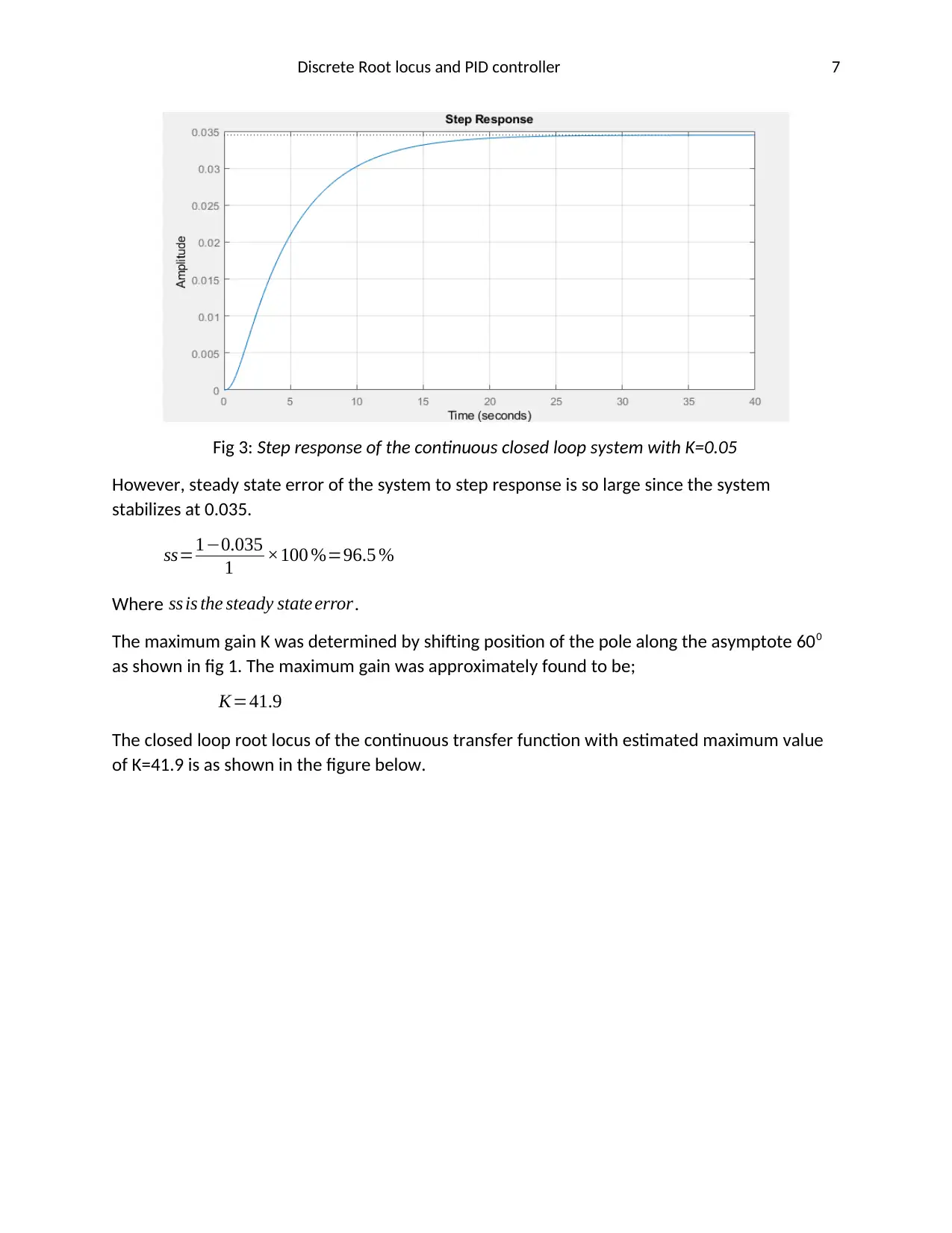
Discrete Root locus and PID controller 7
Fig 3: Step response of the continuous closed loop system with K=0.05
However, steady state error of the system to step response is so large since the system
stabilizes at 0.035.
ss=1−0.035
1 ×100 %=96.5 %
Where ss is the steady state error.
The maximum gain K was determined by shifting position of the pole along the asymptote 600
as shown in fig 1. The maximum gain was approximately found to be;
K=41.9
The closed loop root locus of the continuous transfer function with estimated maximum value
of K=41.9 is as shown in the figure below.
Fig 3: Step response of the continuous closed loop system with K=0.05
However, steady state error of the system to step response is so large since the system
stabilizes at 0.035.
ss=1−0.035
1 ×100 %=96.5 %
Where ss is the steady state error.
The maximum gain K was determined by shifting position of the pole along the asymptote 600
as shown in fig 1. The maximum gain was approximately found to be;
K=41.9
The closed loop root locus of the continuous transfer function with estimated maximum value
of K=41.9 is as shown in the figure below.
Paraphrase This Document
Need a fresh take? Get an instant paraphrase of this document with our AI Paraphraser
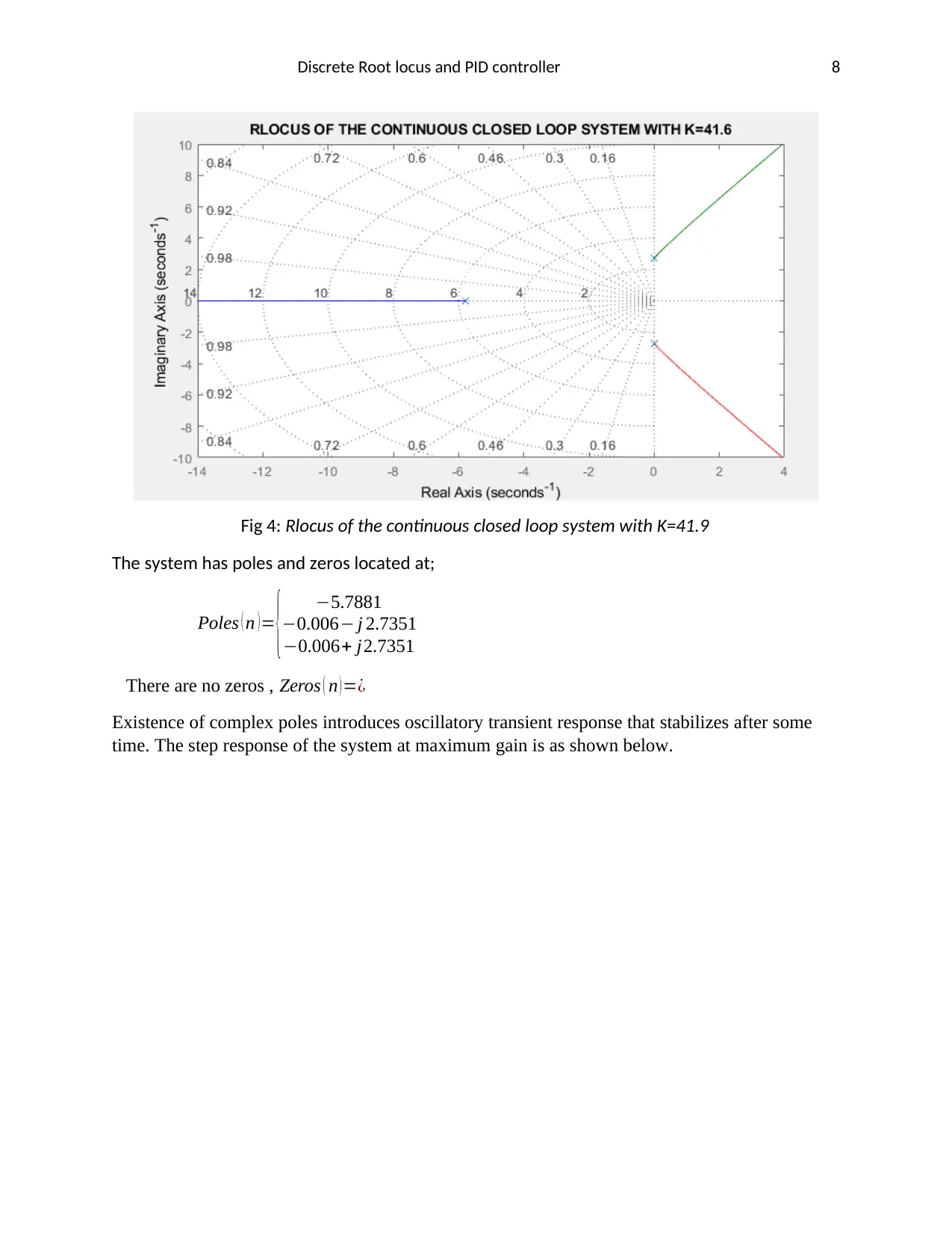
Discrete Root locus and PID controller 8
Fig 4: Rlocus of the continuous closed loop system with K=41.9
The system has poles and zeros located at;
Poles ( n )= { −5.7881
−0.006− j 2.7351
−0.006+ j2.7351
There are no zeros , Zeros ( n ) =¿
Existence of complex poles introduces oscillatory transient response that stabilizes after some
time. The step response of the system at maximum gain is as shown below.
Fig 4: Rlocus of the continuous closed loop system with K=41.9
The system has poles and zeros located at;
Poles ( n )= { −5.7881
−0.006− j 2.7351
−0.006+ j2.7351
There are no zeros , Zeros ( n ) =¿
Existence of complex poles introduces oscillatory transient response that stabilizes after some
time. The step response of the system at maximum gain is as shown below.
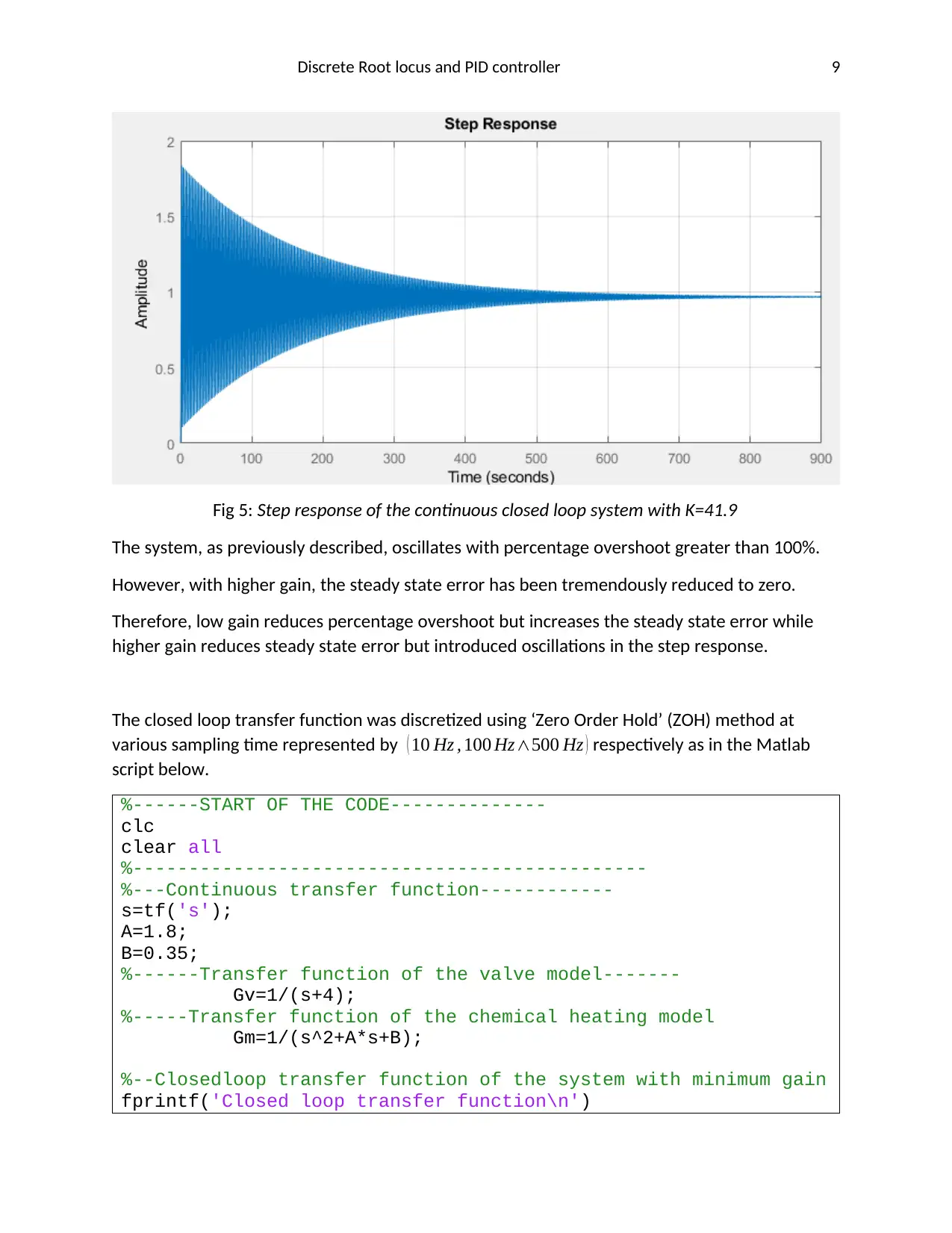
Discrete Root locus and PID controller 9
Fig 5: Step response of the continuous closed loop system with K=41.9
The system, as previously described, oscillates with percentage overshoot greater than 100%.
However, with higher gain, the steady state error has been tremendously reduced to zero.
Therefore, low gain reduces percentage overshoot but increases the steady state error while
higher gain reduces steady state error but introduced oscillations in the step response.
The closed loop transfer function was discretized using ‘Zero Order Hold’ (ZOH) method at
various sampling time represented by ( 10 Hz , 100 Hz∧500 Hz ) respectively as in the Matlab
script below.
%------START OF THE CODE--------------
clc
clear all
%----------------------------------------------
%---Continuous transfer function------------
s=tf('s');
A=1.8;
B=0.35;
%------Transfer function of the valve model-------
Gv=1/(s+4);
%-----Transfer function of the chemical heating model
Gm=1/(s^2+A*s+B);
%--Closedloop transfer function of the system with minimum gain
fprintf('Closed loop transfer function\n')
Fig 5: Step response of the continuous closed loop system with K=41.9
The system, as previously described, oscillates with percentage overshoot greater than 100%.
However, with higher gain, the steady state error has been tremendously reduced to zero.
Therefore, low gain reduces percentage overshoot but increases the steady state error while
higher gain reduces steady state error but introduced oscillations in the step response.
The closed loop transfer function was discretized using ‘Zero Order Hold’ (ZOH) method at
various sampling time represented by ( 10 Hz , 100 Hz∧500 Hz ) respectively as in the Matlab
script below.
%------START OF THE CODE--------------
clc
clear all
%----------------------------------------------
%---Continuous transfer function------------
s=tf('s');
A=1.8;
B=0.35;
%------Transfer function of the valve model-------
Gv=1/(s+4);
%-----Transfer function of the chemical heating model
Gm=1/(s^2+A*s+B);
%--Closedloop transfer function of the system with minimum gain
fprintf('Closed loop transfer function\n')
⊘ This is a preview!⊘
Do you want full access?
Subscribe today to unlock all pages.

Trusted by 1+ million students worldwide
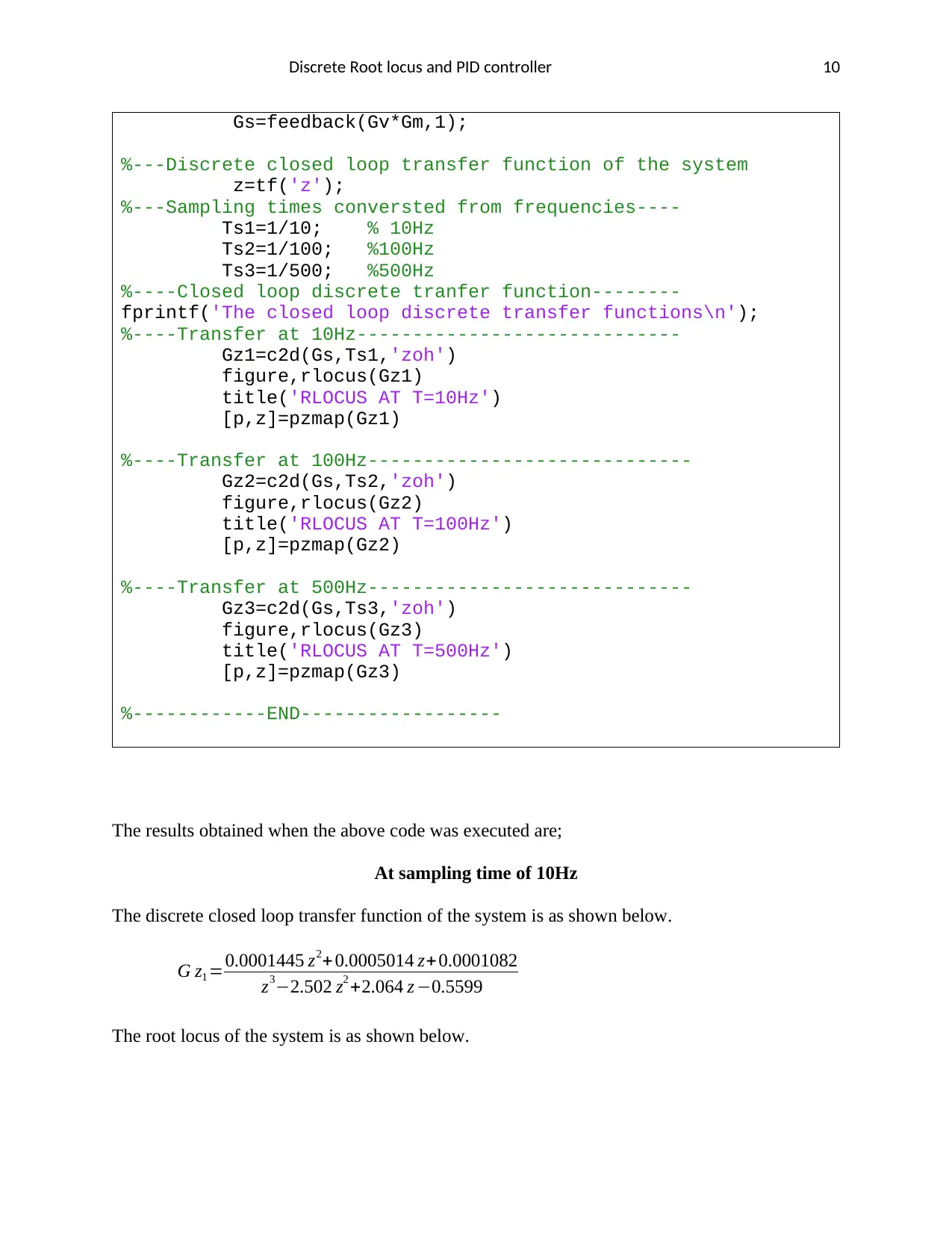
Discrete Root locus and PID controller 10
Gs=feedback(Gv*Gm,1);
%---Discrete closed loop transfer function of the system
z=tf('z');
%---Sampling times conversted from frequencies----
Ts1=1/10; % 10Hz
Ts2=1/100; %100Hz
Ts3=1/500; %500Hz
%----Closed loop discrete tranfer function--------
fprintf('The closed loop discrete transfer functions\n');
%----Transfer at 10Hz-----------------------------
Gz1=c2d(Gs,Ts1,'zoh')
figure,rlocus(Gz1)
title('RLOCUS AT T=10Hz')
[p,z]=pzmap(Gz1)
%----Transfer at 100Hz-----------------------------
Gz2=c2d(Gs,Ts2,'zoh')
figure,rlocus(Gz2)
title('RLOCUS AT T=100Hz')
[p,z]=pzmap(Gz2)
%----Transfer at 500Hz-----------------------------
Gz3=c2d(Gs,Ts3,'zoh')
figure,rlocus(Gz3)
title('RLOCUS AT T=500Hz')
[p,z]=pzmap(Gz3)
%------------END------------------
The results obtained when the above code was executed are;
At sampling time of 10Hz
The discrete closed loop transfer function of the system is as shown below.
G z1 =0.0001445 z2+ 0.0005014 z+0.0001082
z3−2.502 z2 +2.064 z −0.5599
The root locus of the system is as shown below.
Gs=feedback(Gv*Gm,1);
%---Discrete closed loop transfer function of the system
z=tf('z');
%---Sampling times conversted from frequencies----
Ts1=1/10; % 10Hz
Ts2=1/100; %100Hz
Ts3=1/500; %500Hz
%----Closed loop discrete tranfer function--------
fprintf('The closed loop discrete transfer functions\n');
%----Transfer at 10Hz-----------------------------
Gz1=c2d(Gs,Ts1,'zoh')
figure,rlocus(Gz1)
title('RLOCUS AT T=10Hz')
[p,z]=pzmap(Gz1)
%----Transfer at 100Hz-----------------------------
Gz2=c2d(Gs,Ts2,'zoh')
figure,rlocus(Gz2)
title('RLOCUS AT T=100Hz')
[p,z]=pzmap(Gz2)
%----Transfer at 500Hz-----------------------------
Gz3=c2d(Gs,Ts3,'zoh')
figure,rlocus(Gz3)
title('RLOCUS AT T=500Hz')
[p,z]=pzmap(Gz3)
%------------END------------------
The results obtained when the above code was executed are;
At sampling time of 10Hz
The discrete closed loop transfer function of the system is as shown below.
G z1 =0.0001445 z2+ 0.0005014 z+0.0001082
z3−2.502 z2 +2.064 z −0.5599
The root locus of the system is as shown below.
Paraphrase This Document
Need a fresh take? Get an instant paraphrase of this document with our AI Paraphraser
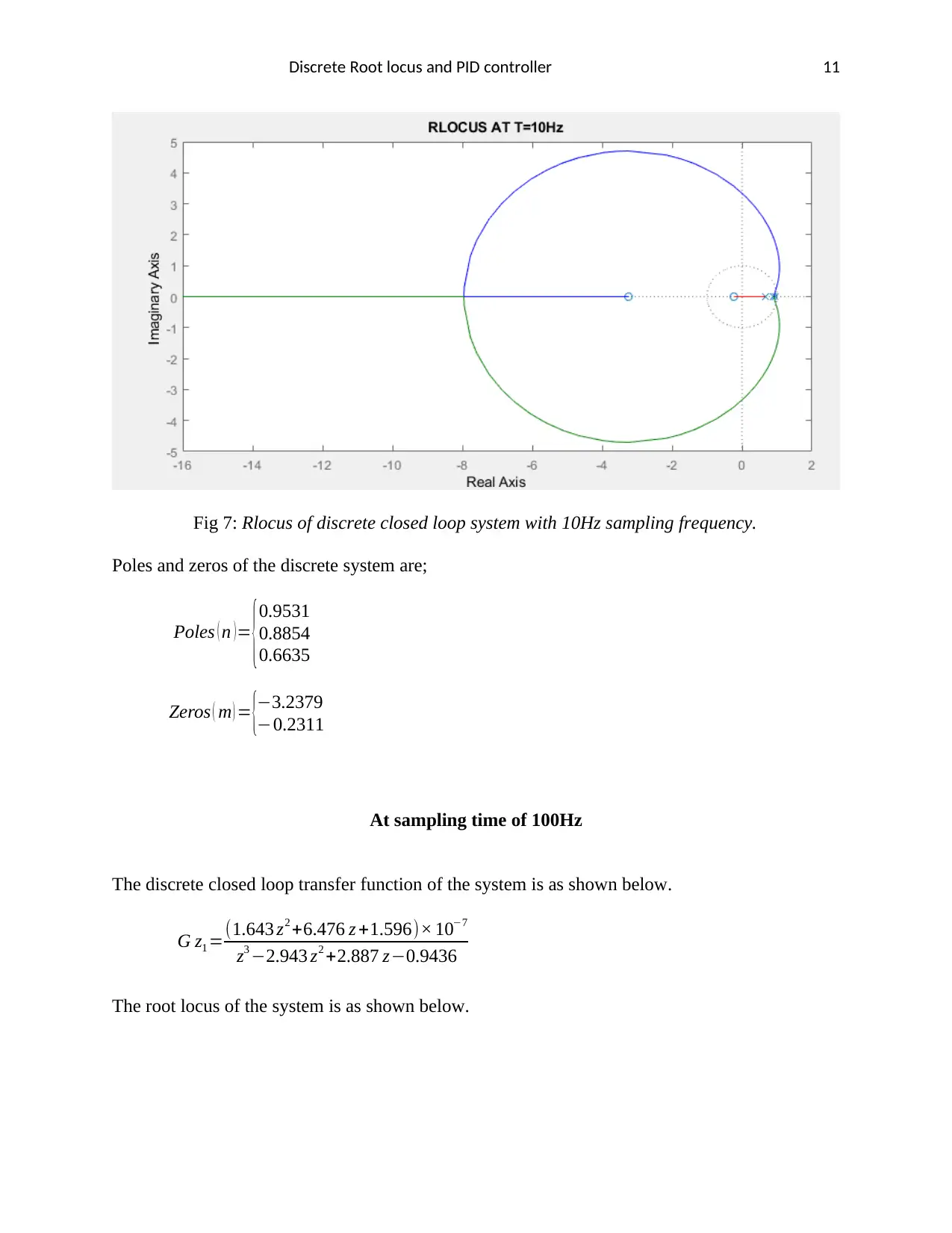
Discrete Root locus and PID controller 11
Fig 7: Rlocus of discrete closed loop system with 10Hz sampling frequency.
Poles and zeros of the discrete system are;
Poles ( n ) = {
0.9531
0.8854
0.6635
Zeros ( m ) = {−3.2379
−0.2311
At sampling time of 100Hz
The discrete closed loop transfer function of the system is as shown below.
G z1 =(1.643 z2 +6.476 z +1.596)× 10−7
z3 −2.943 z2 +2.887 z−0.9436
The root locus of the system is as shown below.
Fig 7: Rlocus of discrete closed loop system with 10Hz sampling frequency.
Poles and zeros of the discrete system are;
Poles ( n ) = {
0.9531
0.8854
0.6635
Zeros ( m ) = {−3.2379
−0.2311
At sampling time of 100Hz
The discrete closed loop transfer function of the system is as shown below.
G z1 =(1.643 z2 +6.476 z +1.596)× 10−7
z3 −2.943 z2 +2.887 z−0.9436
The root locus of the system is as shown below.
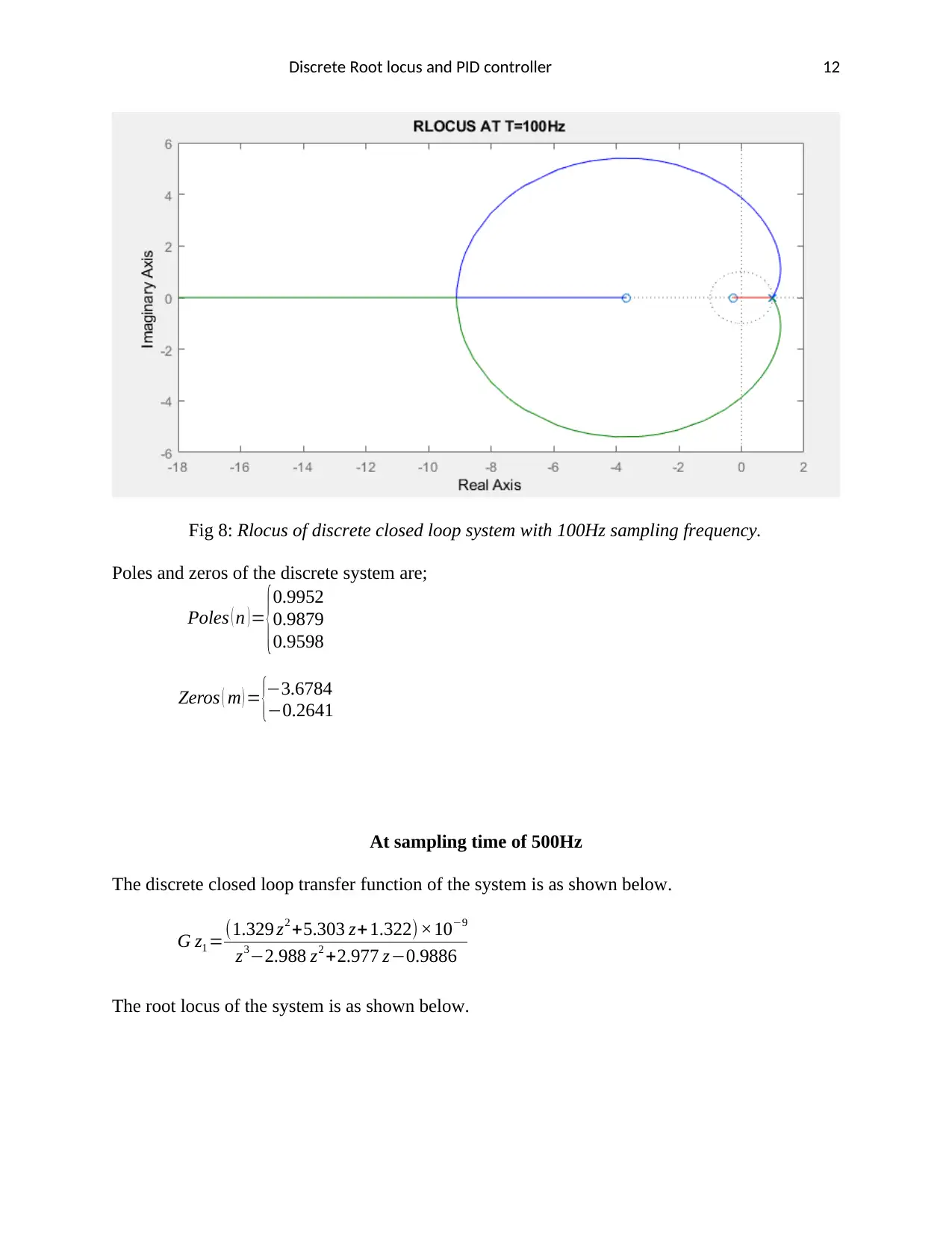
Discrete Root locus and PID controller 12
Fig 8: Rlocus of discrete closed loop system with 100Hz sampling frequency.
Poles and zeros of the discrete system are;
Poles ( n ) = {
0.9952
0.9879
0.9598
Zeros ( m ) = {−3.6784
−0.2641
At sampling time of 500Hz
The discrete closed loop transfer function of the system is as shown below.
G z1 =(1.329 z2 +5.303 z+ 1.322)×10−9
z3−2.988 z2 +2.977 z−0.9886
The root locus of the system is as shown below.
Fig 8: Rlocus of discrete closed loop system with 100Hz sampling frequency.
Poles and zeros of the discrete system are;
Poles ( n ) = {
0.9952
0.9879
0.9598
Zeros ( m ) = {−3.6784
−0.2641
At sampling time of 500Hz
The discrete closed loop transfer function of the system is as shown below.
G z1 =(1.329 z2 +5.303 z+ 1.322)×10−9
z3−2.988 z2 +2.977 z−0.9886
The root locus of the system is as shown below.
⊘ This is a preview!⊘
Do you want full access?
Subscribe today to unlock all pages.

Trusted by 1+ million students worldwide
1 out of 19
Related Documents
Your All-in-One AI-Powered Toolkit for Academic Success.
+13062052269
info@desklib.com
Available 24*7 on WhatsApp / Email
![[object Object]](/_next/static/media/star-bottom.7253800d.svg)
Unlock your academic potential
Copyright © 2020–2025 A2Z Services. All Rights Reserved. Developed and managed by ZUCOL.





